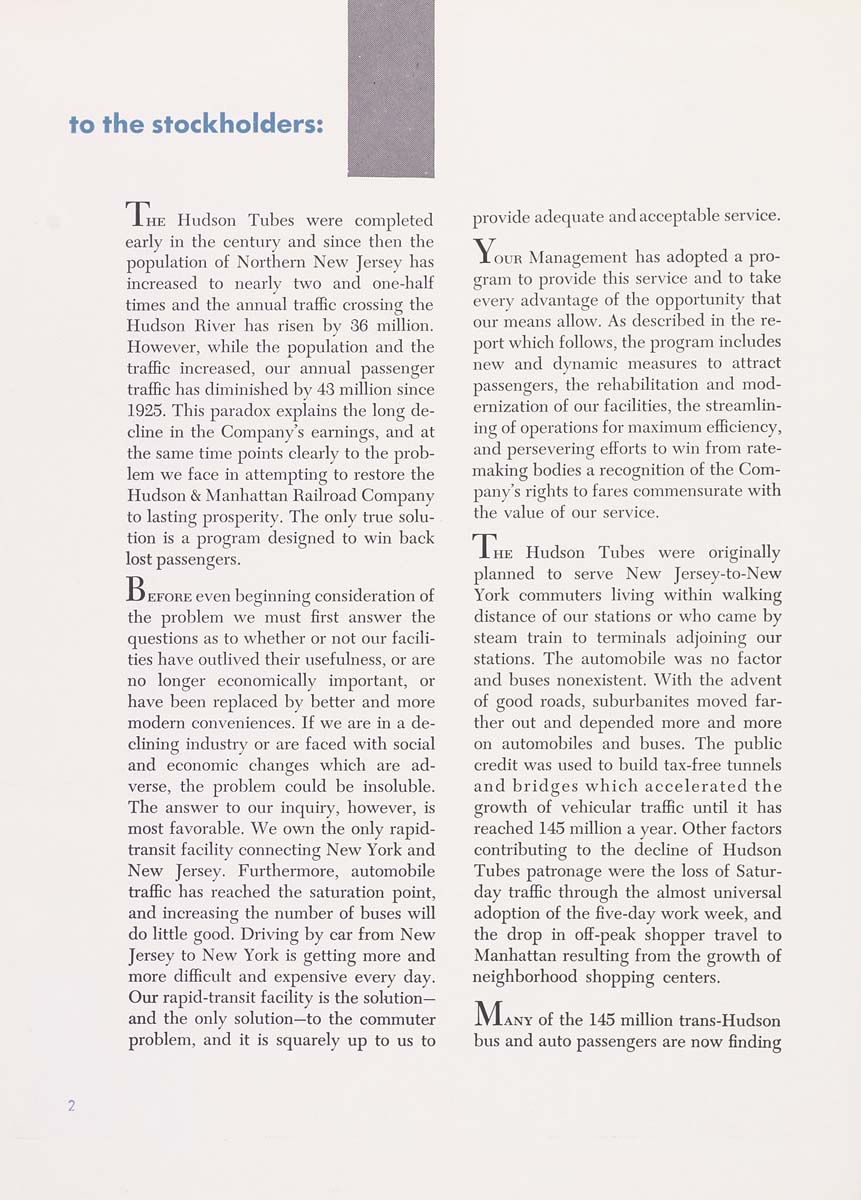Annual report of Hudson & Manhattan Railroad Company
(New York, N.Y. : Hudson and Manhattan Railroad Company )
|
||
|
|
|
|
| 1949: Page 2 |

to the stockholders: !^ve^^ Ihe Hudson Tubes were completed early in the century and since then the population of NortheiTi New Jersey has increased to nearly two and one-half times and the annual traffic crossing the Hudson River has risen by 36 million. However, while the population and the traffic increased, our annual passenger traffic has diminished by 43 million since 1925. This paradox explains the long de¬ cline in the Company's earnings, and at the same time points clearly to the prob¬ lem we face in attempting to restore the Hudson & Manhattan Railroad Company to lasting prosperity. The only true solu¬ tion is a program designed to win back lost passengers. Ijefore even beginning consideration of the problem we must first answer the questions as to whether or not our facili¬ ties have outlived their usefulness, or are no longer economically important, or have been replaced by better and more modern conveniences. If we are in a de¬ clining industry or are faced with social and economic changes which are ad¬ verse, the problem could be insoluble. The answer to our inquiry, however, is most favorable. We own the only rapid- transit facility connecting New York and New Jersey. Furthermore, automobile traffic has reached the saturation point, and increasing the number of buses will do little good. Driving by car from New Jersey to New York is getting more and more difficult and expensive every day. Our rapid-transit facility is the solution— and the only solution—to the commuter problem, and it is squarely up to us to provide adequate and acceptable service. Xoua Management has adopted a pro¬ gram to provide this service and to take every advantage of the opportunity that our means allow. As described in the re¬ port which follows, the program includes new and dynamic measures to attract passengers, the rehabilitation and mod¬ ernization of our facilities, the streamlin¬ ing of operations for maximum efficiency, and persevering eftorts to win from rate- making bodies a recognition of the Com¬ pany's rights to fares commensurate with the value of our service. Ihe Hudson Tubes were originally planned to serve New Jersey-to-New York commuters living within walking distance of our stations or who came by steam train to terminals adjoining our stations. The automobile was no factor and buses nonexistent. With the advent of good roads, suburbanites moved far¬ ther out and depended more and more on automobiles and buses. The public credit was used to build tax-free tunnels and bridges which accelerated the growth of vehicular traffic until it has reached 145 million a year. Other factors contributing to the decline of Hudson Tubes patronage were the loss of Satur¬ day traffic through the almost universal adoption of the five-day work week, and the drop in off-peak shopper travel to Manhattan resulting from the growth of neighborhood shopping centers. IVIany of the 145 million trans-Hudson bus and auto passengers are now finding |
| 1949: Page 2 |







